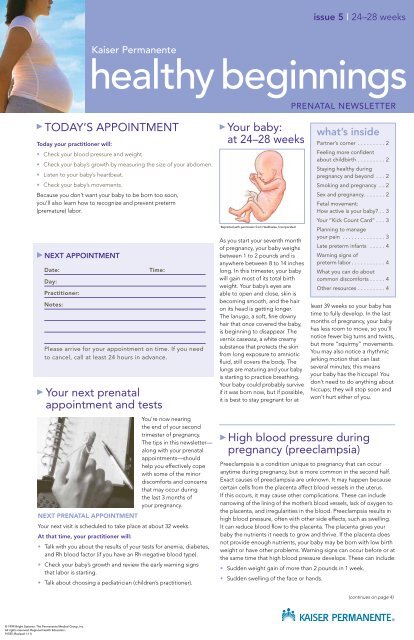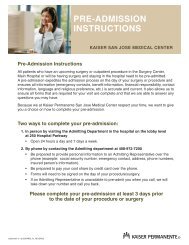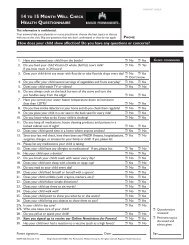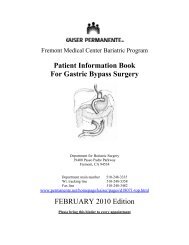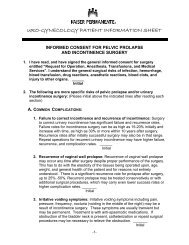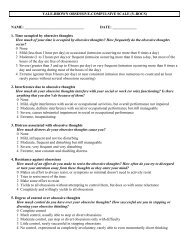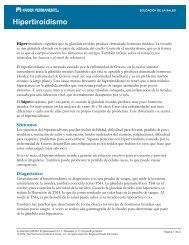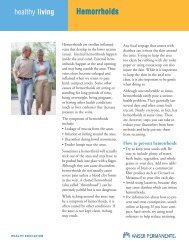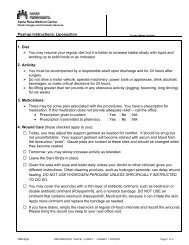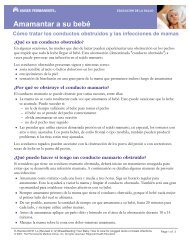24 to 28 weeks (PDF) - Kaiser Permanente
24 to 28 weeks (PDF) - Kaiser Permanente
24 to 28 weeks (PDF) - Kaiser Permanente
You also want an ePaper? Increase the reach of your titles
YUMPU automatically turns print PDFs into web optimized ePapers that Google loves.
issue 5 <strong>24</strong>–<strong>28</strong> <strong>weeks</strong><br />
<strong>Kaiser</strong> <strong>Permanente</strong><br />
healthy beginnings<br />
PRENATAL NEWSLETTER<br />
▲ ▲ ▲<br />
TODAY’S APPOINTMENT<br />
Today your practitioner will:<br />
• Check your blood pressure and weight.<br />
• Check your baby’s growth by measuring the size of your abdomen.<br />
• Listen <strong>to</strong> your baby’s heartbeat.<br />
• Check your baby’s movements.<br />
Because you don’t want your baby <strong>to</strong> be born <strong>to</strong>o soon,<br />
you’ll also learn how <strong>to</strong> recognize and prevent preterm<br />
(premature) labor.<br />
NEXT APPOINTMENT<br />
Date:<br />
Day:<br />
Practitioner:<br />
Notes:<br />
Your next prenatal<br />
appointment and tests<br />
NEXT PRENATAL APPOINTMENT<br />
You’re now nearing<br />
the end of your second<br />
trimester of pregnancy.<br />
The tips in this newsletter—<br />
along with your prenatal<br />
appointments—should<br />
help you effectively cope<br />
with some of the minor<br />
discomforts and concerns<br />
that may occur during<br />
the last 3 months of<br />
your pregnancy.<br />
Your next visit is scheduled <strong>to</strong> take place at about 32 <strong>weeks</strong>.<br />
At that time, your practitioner will:<br />
Time:<br />
Please arrive for your appointment on time. If you need<br />
<strong>to</strong> cancel, call at least <strong>24</strong> hours in advance.<br />
• Talk with you about the results of your tests for anemia, diabetes,<br />
and Rh blood fac<strong>to</strong>r (if you have an Rh-negative blood type).<br />
• Check your baby’s growth and review the early warning signs<br />
that labor is starting.<br />
• Talk about choosing a pediatrician (children’s practitioner).<br />
▲ ▲<br />
Your baby:<br />
at <strong>24</strong>–<strong>28</strong> <strong>weeks</strong><br />
Reprinted with permission from Healthwise, Incorporated.<br />
As you start your seventh month<br />
of pregnancy, your baby weighs<br />
between 1 <strong>to</strong> 2 pounds and is<br />
anywhere between 8 <strong>to</strong> 14 inches<br />
long. In this trimester, your baby<br />
will gain most of its <strong>to</strong>tal birth<br />
weight. Your baby’s eyes are<br />
able <strong>to</strong> open and close, skin is<br />
becoming smooth, and the hair<br />
on its head is getting longer.<br />
The lanugo, a soft, fine downy<br />
hair that once covered the baby,<br />
is beginning <strong>to</strong> disappear. The<br />
vernix caseosa, a white creamy<br />
substance that protects the skin<br />
from long exposure <strong>to</strong> amniotic<br />
fluid, still covers the body. The<br />
lungs are maturing and your baby<br />
is starting <strong>to</strong> practice breathing.<br />
Your baby could probably survive<br />
if it was born now, but if possible,<br />
it is best <strong>to</strong> stay pregnant for at<br />
High blood pressure during<br />
pregnancy (preeclampsia)<br />
Preeclampsia is a condition unique <strong>to</strong> pregnancy that can occur<br />
anytime during pregnancy, but is more common in the second half.<br />
Exact causes of preeclampsia are unknown. It may happen because<br />
certain cells from the placenta affect blood vessels in the uterus.<br />
If this occurs, it may cause other complications. These can include<br />
narrowing of the lining of the mother’s blood vessels, lack of oxygen <strong>to</strong><br />
the placenta, and irregularities in the blood. Preeclampsia results in<br />
high blood pressure, often with other side effects, such as swelling.<br />
It can reduce blood flow <strong>to</strong> the placenta. The placenta gives your<br />
baby the nutrients it needs <strong>to</strong> grow and thrive. If the placenta does<br />
not provide enough nutrients, your baby may be born with low birth<br />
weight or have other problems. Warning signs can occur before or at<br />
the same time that high blood pressure develops. These can include:<br />
• Sudden weight gain of more than 2 pounds in 1 week.<br />
• Sudden swelling of the face or hands.<br />
what’s inside<br />
Partner’s corner .........2<br />
Feeling more confident<br />
about childbirth .........2<br />
Staying healthy during<br />
pregnancy and beyond ...2<br />
Smoking and pregnancy ..2<br />
Sex and pregnancy . ......2<br />
Fetal movement:<br />
How active is your baby? . .3<br />
Your “Kick Count Card” . ..3<br />
Planning <strong>to</strong> manage<br />
your pain ..............3<br />
Late preterm infants .....4<br />
Warning signs of<br />
preterm labor . ..........4<br />
What you can do about<br />
common discomforts . ....4<br />
Other resources . ........4<br />
least 39 <strong>weeks</strong> so your baby has<br />
time <strong>to</strong> fully develop. In the last<br />
months of pregnancy, your baby<br />
has less room <strong>to</strong> move, so you’ll<br />
notice fewer big turns and twists,<br />
but more “squirmy” movements.<br />
You may also notice a rhythmic<br />
jerking motion that can last<br />
several minutes; this means<br />
your baby has the hiccups! You<br />
don’t need <strong>to</strong> do anything about<br />
hiccups; they will s<strong>to</strong>p soon and<br />
won’t hurt either of you.<br />
(continues on page 4)<br />
© 1999 Bright Systems. The <strong>Permanente</strong> Medical Group, Inc.<br />
All rights reserved. Regional Health Education.<br />
91555 (Revised 1-11)
▲ ▲<br />
PARTNER’S CORNER<br />
Amazing as it might seem, babies can hear you talk <strong>to</strong> them months<br />
before they are born. Research has shown that babies hear sounds<br />
outside the mother’s womb and they respond by kicking or moving.<br />
Talking <strong>to</strong> your baby will help your baby recognize your voice and<br />
be comforted by it, both now and after birth. Decide with your<br />
partner about good times <strong>to</strong> talk <strong>to</strong> your baby. Choose times when<br />
you both feel relaxed and happy, such as in the evening or just<br />
before going <strong>to</strong> sleep.<br />
• Enjoy yourself. Have fun trying this out, even if it seems silly at first.<br />
• Speak <strong>to</strong> the baby loudly enough that you could be heard from<br />
across the room.<br />
• The baby may or may not move each time you speak, so don’t<br />
expect <strong>to</strong>o much.<br />
FEELING MORE CONFIDENT ABOUT CHILDBIRTH<br />
There are a few things you can do <strong>to</strong> decrease anxiety and feel more<br />
confident about childbirth:<br />
• Take a childbirth preparation class. Once you know what <strong>to</strong><br />
expect, much of the fear and anxiety should go away.<br />
• In the classes, you’ll learn how <strong>to</strong> actively support your partner<br />
by using relaxation techniques, such as massage and deep<br />
breathing. Practice these techniques with your partner <strong>to</strong> become<br />
comfortable doing them.<br />
• Trust yourself. Most labor support people rise <strong>to</strong> the occasion.<br />
Staying healthy during<br />
pregnancy and beyond<br />
TAKING A BATH<br />
Well-meaning friends and relatives may offer you advice that conflicts<br />
with what your practitioner tells you. Practitioners believe that, unless<br />
water is forced in<strong>to</strong> the vagina (as in douching), the mucous plug<br />
adequately protects the uterus and fetus from infection by sealing<br />
off the cervix. With <strong>to</strong>day’s sanitary conditions, vaginal infections<br />
from bathwater are not a real concern.<br />
Therefore, most practitioners will advise you <strong>to</strong> bathe up until you<br />
rupture your bag of waters (just before or during labor). However,<br />
for safety reasons, showers may be recommended instead of baths.<br />
Your center of gravity and balance change as your uterus grows, and<br />
the bathtub is an easy place <strong>to</strong> slip and fall. If you take a bath, use a<br />
rubber mat <strong>to</strong> prevent slipping. If needed, have someone help you<br />
out of the tub. Remember, if you take a bath, use warm water, not hot.<br />
WEIGHT GAIN<br />
It’s recommended that you gain about 25 <strong>to</strong> 35 pounds throughout<br />
your entire pregnancy. This will vary, of course, depending upon<br />
your weight before pregnancy. Talk <strong>to</strong> your practitioner about how<br />
much weight you should gain. Babies who are larger than average<br />
at the time of birth are at higher risk for being overweight and for<br />
having other health problems. Losing weight during pregnancy can<br />
harm your baby.<br />
To get an idea of how much weight you should gain throughout your<br />
pregnancy, start by calculating what your Body Mass Index (BMI) was<br />
at the beginning of pregnancy. Type in “BMI” in “Search our site”<br />
on kp.org. Enter your height and weight, click “Calculate,” and your<br />
BMI will result. Check the chart below <strong>to</strong> see where your BMI number<br />
falls and the corresponding weight gain recommendations.<br />
▲ ▲<br />
Smoking and pregnancy<br />
If you’ve quit smoking, congratulations! If you smoke,<br />
try <strong>to</strong> s<strong>to</strong>p now—for your health and your baby’s.<br />
• Women who smoke are more likely <strong>to</strong> have problems in<br />
pregnancy and childbirth.<br />
• They tend <strong>to</strong> have premature and smaller (underdeveloped)<br />
babies who have problems after birth and throughout life.<br />
• Smoking during pregnancy can cause your baby <strong>to</strong> be born<br />
underweight, which puts your baby at greater risk of serious<br />
illness, chronic lifelong disabilities, and even death.<br />
• The risk of sudden infant death syndrome (SIDS), or “crib death,”<br />
increases if a mother smokes during or after pregnancy.<br />
• Children from smoking households have 4 times as many<br />
respira<strong>to</strong>ry infections (lung, sinus, and ear infections) as those<br />
from nonsmoking households.<br />
• If you’ve quit smoking, it’s important <strong>to</strong> stay smoke-free during<br />
pregnancy and after your baby is born. Not smoking will help your<br />
health and the health of your family. You’ve worked hard <strong>to</strong> s<strong>to</strong>p<br />
smoking. Use your new skills <strong>to</strong> remain smoke-free.<br />
• Encourage your partner or other family members <strong>to</strong> quit<br />
smoking with you. It’s easier not <strong>to</strong> smoke when you’re<br />
surrounded by other nonsmokers. Support each other in<br />
staying smoke-free.<br />
• Talk with your practitioner or visit your local Health Education<br />
Center for help with quitting smoking or staying quit. Some<br />
facilities offer smoking cessation programs specifically for<br />
pregnant women.<br />
If you smoke,<br />
try <strong>to</strong> s<strong>to</strong>p now.<br />
Sex and pregnancy<br />
You can enjoy a sexual relationship with your partner throughout<br />
pregnancy, unless you have been <strong>to</strong>ld that you’re at high risk for<br />
preterm labor or that your placenta is over your cervix (placenta<br />
previa). If you have either of these conditions, talk with your<br />
practitioner. Pregnancy can be a time <strong>to</strong> find new ways <strong>to</strong> enjoy<br />
making love. You can also explore new ways if intercourse<br />
becomes uncomfortable in late pregnancy. (See Healthy<br />
Beginnings, Issue 1 for more discussion on sex and pregnancy.)<br />
• You may have a slight, bloody vaginal discharge or mild<br />
contractions after intercourse. This is normal as long as the<br />
contractions or discharge don’t continue for more than 1 hour.<br />
• Check the warning signs of preterm labor on page 3 of this<br />
newsletter.<br />
Contact your practitioner now if:<br />
• You think your bag of waters might be broken (there is a gush or<br />
continuous trickle of pale, sweet-smelling liquid<br />
from the vagina).<br />
• Your contractions continue for more than 1 hour after<br />
having sex.<br />
Weight status at<br />
beginning of pregnancy<br />
Underweight<br />
( BMI less than 18.5 )<br />
Normal<br />
( BMI 18.5 – <strong>24</strong>.9 )<br />
Overweight<br />
( BMI 25 – 29.9 )<br />
Obese<br />
( BMI 30 or greater )<br />
Recommended Weight Gain<br />
1 st Trimester: 2 nd Trimester: 3 rd Trimester: Over 9 Months:<br />
1 - 4.5 pounds <strong>to</strong>tal Slightly over 1 pound<br />
per week<br />
1 - 4.5 pounds <strong>to</strong>tal About 1 pound<br />
every week<br />
1 - 4.5 pounds <strong>to</strong>tal Slightly over ½ a pound<br />
every week<br />
1 - 4.5 pounds <strong>to</strong>tal Slightly under ½ a pound<br />
every week<br />
Slightly over 1 pound<br />
per week<br />
Slightly over 1 pound<br />
per week<br />
Slightly over ½ a pound<br />
every week<br />
Slightly under ½ a pound<br />
every week<br />
<strong>28</strong>-40 pounds<br />
25-35 pounds<br />
15-25 pounds<br />
11-20 pounds<br />
2<br />
healthy beginnings issue 5 | <strong>24</strong>–<strong>28</strong> <strong>weeks</strong>
▲<br />
Fetal movement: How active is your baby?<br />
For several <strong>weeks</strong> now, you’ve felt your baby twist, turn, stretch, roll, and kick.<br />
You may notice that your baby favors a particular position or has a favorite time<br />
of day <strong>to</strong> be most active.<br />
In studying fetal movement, here’s what researchers have found:<br />
• Your baby sleeps about 20 <strong>to</strong> 45 minutes at a time. During sleep, the baby is<br />
quiet and may even be sucking a thumb or finger.<br />
• The baby’s movements will change as he or she grows bigger and gets in<strong>to</strong><br />
position for birth. You will feel fewer big turns and twists, but more kicks and<br />
jabs as your pregnancy progresses.<br />
• There will be certain times of the day when your baby is very active. Although many<br />
babies are especially active during the evening or at bedtime, your baby could be<br />
moving at any time, day or night.<br />
• Each baby is unique and will move in its own way. You should feel your baby move<br />
several times every day. An active baby is a healthy baby.<br />
▲<br />
Your “Kick Count Card”<br />
At some facilities, you will get a Kick Count Card from your practitioner<br />
when you’re in week <strong>28</strong> of pregnancy. You will need <strong>to</strong> fill it out daily and<br />
bring it with you <strong>to</strong> every visit during the pregnancy.<br />
HOW TO FILL OUT YOUR KICK COUNT CARD<br />
The best time <strong>to</strong> count your baby’s kicks is after the evening meal. (That’s when<br />
developing babies are most active.) Follow these 7 steps:<br />
1. Go <strong>to</strong> the bathroom and empty your bladder.<br />
2. Lie down on your side or relax in a comfortable chair.<br />
3. Look at the clock. Write down the time when you start.<br />
4. Pay attention only <strong>to</strong> your baby’s movements. Count any movement that you<br />
can feel (except hiccups). Any twist, kick, or turn equals 1 movement.<br />
5. When you’ve counted 10 movements, look at the clock again.<br />
6. Write down how many minutes it <strong>to</strong>ok for your baby <strong>to</strong> move 10 times.<br />
7. Check off this number on your Kick Count Card.<br />
A SAMPLE KICK COUNT CARD<br />
On Monday:<br />
• You start <strong>to</strong> count your baby’s kicks at 7 p.m.<br />
• By 7:30 p.m., your baby has kicked or moved 10<br />
times.<br />
• That’s 30 minutes for your baby <strong>to</strong> kick 10 times.<br />
• On M (for Monday), put an X next <strong>to</strong> “30”<br />
in the column.<br />
If your baby does not kick or move within the<br />
first hour after you’ve begun the kick count:<br />
• Eat or drink something, such as fruit or juice,<br />
then lie on your left side and concentrate on your<br />
baby. Babies are most active after you eat or drink.<br />
• Or walk around for 5 minutes, and then begin<br />
counting again.<br />
Notify Labor and Delivery (or the Member Service Center) now if your baby has<br />
not moved 10 times by the end of 2 hours or has a sudden decrease in normal<br />
activity. It could mean that your baby is having problems. If this is the case, you’ll need<br />
<strong>to</strong> have a simple test called a “non-stress test” right away. This test uses an electronic<br />
fetal moni<strong>to</strong>r <strong>to</strong> record your baby’s heartbeat and any contractions you might be having.<br />
▲<br />
Planning <strong>to</strong> manage<br />
your pain<br />
All women experience some discomfort<br />
during labor. Childbirth preparation/Lamaze<br />
classes are highly recommended for learning<br />
breathing and relaxation techniques. These<br />
are skills that will help you deal with pain<br />
during early labor. Whether or not you<br />
decide <strong>to</strong> give birth with pain relief<br />
medication, you should know some simple<br />
relaxation techniques and know what<br />
medicines are available <strong>to</strong> you.<br />
You and your practitioner can decide whether<br />
<strong>to</strong> use pain relief medications by carefully<br />
considering your comfort and the baby’s<br />
safety. Make sure <strong>to</strong> complete the birth plan,<br />
if you are provided one. A birth plan allows<br />
you <strong>to</strong> communicate your preferences for<br />
childbirth with the labor and delivery staff.<br />
If you’re planning on using pain medication,<br />
childbirth preparation classes can help you<br />
develop the skills necessary <strong>to</strong> deal with early<br />
labor. (However, even with medication, it’s<br />
unrealistic <strong>to</strong> expect no discomfort during<br />
your entire labor.)<br />
• Unmedicated birth. Whether <strong>to</strong> use<br />
pain medications during labor and delivery<br />
is a personal choice. If you prefer<br />
a natural or unmedicated childbirth, we<br />
can support you in your decision.<br />
• Analgesics. Analgesics are pain medications,<br />
such as opioids or narcotics, which<br />
are given through an IV or by injection<br />
<strong>to</strong> lessen the pain of contractions. These<br />
medications are almost always used well<br />
before delivery because they can affect a<br />
newborn’s breathing right after birth.<br />
• Regional anesthetics. Regional anesthetics,<br />
epidural or spinal, decrease<br />
sensations from the abdomen <strong>to</strong> the<br />
<strong>to</strong>es. Medication is given through a<br />
small tube (a catheter) that is inserted<br />
in<strong>to</strong> the lower back. Epidural anesthetics<br />
are available during labor <strong>to</strong> decrease or<br />
eliminate contraction pain. If you require<br />
a cesarean section, a regional anesthetic<br />
will numb the abdomen but will allow you<br />
<strong>to</strong> remain awake during the birth.<br />
Local anesthetics may be used at the time<br />
of delivery <strong>to</strong> numb the vaginal area. General<br />
anesthetics, which put people <strong>to</strong> sleep,<br />
are used only in rare cases.<br />
You and your practitioner can decide<br />
whether <strong>to</strong> use pain relief medications by<br />
carefully considering your comfort and the<br />
baby’s safety.<br />
Call your practitioner now if you have:<br />
• Pelvic pain, other than mild cramping.<br />
• Pain or fever with vomiting more than 2 <strong>to</strong> 3 times a day<br />
or that lasts more than an hour.<br />
• Headaches with muscle weakness, visual problems, or fever.<br />
• Headaches that don’t respond <strong>to</strong> acetaminophen (such as Tylenol).<br />
• Nosebleeds that won’t s<strong>to</strong>p.<br />
• Burning or pain when you urinate.<br />
• Cramping in your leg or foot that won’t go away.<br />
Call Labor and Delivery (or your Member<br />
Service Center) if you have:<br />
• Warning signs of preterm labor.<br />
• Fainting spells or dizziness.<br />
• Blurred vision.<br />
• Pain in your chest or abdomen.<br />
• Fever (temperature of 100.4° or greater).<br />
• Sudden puffiness in your hands or face.<br />
• Sudden weight gain of more than 2 pounds in 1 week.<br />
healthy beginnings issue 5 | <strong>24</strong>–<strong>28</strong> <strong>weeks</strong><br />
3
4<br />
▲ ▲<br />
▲<br />
Late preterm<br />
infants<br />
Late preterm infants (LPI) are born<br />
between 34 <strong>to</strong> 36 <strong>weeks</strong> gestation. LPIs,<br />
also known as near-term infants, are at<br />
a greater risk for health problems than<br />
babies born at term. Every newborn needs<br />
special care but late preterm infants need<br />
even extra care <strong>to</strong> fully develop and grow. If<br />
your baby is born between 34 <strong>to</strong> 36 <strong>weeks</strong><br />
gestation, he or she may require:<br />
• Care in the hospital for more than<br />
one or two days.<br />
• Special attention <strong>to</strong> establishing<br />
breast feeding.<br />
• Careful pediatric follow-up.<br />
Warning signs<br />
of preterm labor<br />
Warning signs of preterm (premature)<br />
labor may be more subtle than the signs<br />
of labor at full term (39-40 <strong>weeks</strong>). (See<br />
“Preterm (premature) birth” in Healthy<br />
Beginnings, Issue 4.) Waiting <strong>to</strong> call for<br />
help could result in the preterm birth of<br />
your baby. Call Labor and Delivery (or your<br />
Member Service Center) if you have:<br />
• Menstrual-like cramps (usually in the<br />
lower abdomen) that may come and go or<br />
remain constant. They may also occur with<br />
or without nausea, diarrhea, or indigestion.<br />
• Contractions that feel like a tightening<br />
of your abdomen every 10 minutes or<br />
more frequently within one hour.<br />
• Low, dull backache below the waist<br />
that does not go away when you<br />
change position or rest on your side,<br />
or a rhythmic backache that comes and<br />
goes in a pattern (back labor).<br />
• Pelvic pressure or pain that comes and<br />
goes in a rhythmic pattern in the lower<br />
abdomen, back, and/or thighs (described<br />
as a “heaviness in the pelvis”).<br />
• Intestinal cramping or flu-like<br />
symp<strong>to</strong>ms, with or without diarrhea.<br />
• Increase or change in vaginal discharge<br />
(leaking a heavy or mucous-like fluid, a<br />
watery discharge, or blood).<br />
Other resources<br />
KAISER PERMANENTE WEB SITE<br />
Connect <strong>to</strong> our Web site at kp.org or<br />
kp.org/pregnancy.<br />
NATIONAL DOMESTIC VIOLENCE<br />
HOTLINE<br />
Your health and your pregnancy can be<br />
seriously affected by violence or abuse. If<br />
you are hit, hurt or threatened by a partner<br />
or spouse, there is help. Call the National<br />
Domestic Violence Hotline at 1-800-799-7233<br />
or connect <strong>to</strong> ndvh.org.<br />
The information in Healthy Beginnings is not intended <strong>to</strong><br />
diagnose health problems or <strong>to</strong> take the place of medical<br />
advice or care you receive from your practitioner. If you have<br />
persistent health problems, or if you have further questions,<br />
please consult your practitioner. If you have questions or<br />
need additional information about your medication, please<br />
speak <strong>to</strong> your pharmacist. <strong>Kaiser</strong> <strong>Permanente</strong> does not endorse<br />
the medications or products mentioned. Any trade names listed<br />
are for easy identification only.<br />
healthy beginnings issue 5 | <strong>24</strong>–<strong>28</strong> <strong>weeks</strong><br />
▲<br />
▲<br />
What you can do about common discomforts<br />
PAINFUL KICKING<br />
Your baby may settle in<strong>to</strong> a position<br />
that is very uncomfortable for you. Your<br />
baby’s kicks and twists can be strong and<br />
sometimes painful. When your baby drops<br />
in<strong>to</strong> the pelvis (called “lightening”), the<br />
kicks will probably be less uncomfortable.<br />
If you’re having your first baby, lightening<br />
can occur several <strong>weeks</strong> before delivery.<br />
For subsequent babies, it usually doesn’t<br />
happen until just before labor. If the baby’s<br />
movements are causing you discomfort:<br />
• Change your position and hope your<br />
baby changes position, <strong>to</strong>o.<br />
• Try taking a deep breath while you<br />
raise your arm over your head and then<br />
breathe out while you drop your arm.<br />
• Try cupping your hands around your<br />
baby’s but<strong>to</strong>cks and gently moving the<br />
baby.<br />
PELVIC PRESSURE OR PAIN<br />
Sharp, lower, midline pain is sometimes<br />
caused when a joint at the front of the pelvis<br />
(symphysis pubis) relaxes in response <strong>to</strong><br />
pregnancy hormones. You may feel pelvic<br />
pressure or pain if your baby’s head is low in<br />
the pelvis (after lightening occurs). Lying on<br />
your side may help relieve this discomfort.<br />
You might have groin discomfort as the<br />
round ligaments that support the uterus<br />
continue <strong>to</strong> stretch. Many women find wearing<br />
a “pregnancy belt”, which is a support<br />
that goes around your back and down below<br />
your uterus, <strong>to</strong> be helpful. Again, resting<br />
on your side might help. Also, be sure<br />
<strong>to</strong> get up slowly from a sitting or lying down<br />
position. Slowly roll on<strong>to</strong> your side when<br />
getting up from a lying down position, and<br />
use your arms <strong>to</strong> get up. This helps prevent<br />
strain <strong>to</strong> your round ligament, causing ligament<br />
pain.<br />
LEAKING URINE<br />
As your growing uterus puts pressure<br />
on your bladder, you might notice<br />
that you leak urine when you laugh or<br />
cough. This is common and is called<br />
“stress incontinence.”<br />
You can help prevent leaking by doing<br />
Kegel exercises, which will strengthen<br />
your pelvic floor muscles and help reduce<br />
leaking. You can do these exercises<br />
anytime—standing, sitting, waiting for<br />
a red light <strong>to</strong> change, or even while you’re<br />
washing the dishes. Here’s how:<br />
• Protein in your urine.<br />
• Moderate or severe headaches that do not<br />
go away with acetaminophen (such as Tylenol)<br />
and rest.<br />
• Blurred vision or other visual problems (like<br />
seeing spots).<br />
• Pain in the upper abdomen that does not<br />
go away with antacids (such as Tums or<br />
Mylanta).<br />
• Firmly tighten the muscles around your<br />
vagina, as you would <strong>to</strong> s<strong>to</strong>p urinating<br />
(peeing). It’s not recommended that you<br />
perform Kegel exercises while on the<br />
<strong>to</strong>ilet since this may strain the pelvic<br />
floor muscles.<br />
• Hold tightly for as long as you can<br />
(up <strong>to</strong> 8 <strong>to</strong> 10 seconds).<br />
• Then slowly release the muscles<br />
and relax.<br />
• Remember <strong>to</strong> keep breathing as<br />
you hold the muscles.<br />
• Repeat 10 <strong>to</strong> 15 times, 3 <strong>to</strong> 4 times daily.<br />
Don’t drink less fluid <strong>to</strong> keep urine from<br />
leaking; it won’t work! It will also not keep<br />
you from needing <strong>to</strong> get up at night <strong>to</strong> empty<br />
your bladder. You still need fluids <strong>to</strong> keep<br />
yourself and your baby healthy. Not drinking<br />
enough fluids may lead <strong>to</strong> preterm labor.<br />
Call your practitioner immediately if you<br />
need a pad <strong>to</strong> keep your underwear dry.<br />
This could mean that you have a leak in<br />
your bag of waters.<br />
SWOLLEN FEET AND ANKLES<br />
You may notice that your feet, ankles,<br />
hands, and fingers will become swollen,<br />
particularly at the end of the day. It’s normal<br />
<strong>to</strong> have extra fluid in your tissues during<br />
pregnancy, but much of the swelling should<br />
disappear after a good night’s sleep. If your<br />
fingers are puffy, remove your rings. Do<br />
not take diuretics (water pills) because they<br />
interfere with your normal fluid balance.<br />
Tips <strong>to</strong> prevent swelling or puffiness:<br />
• Avoid high-sodium (salty) foods. (Aim for<br />
less than <strong>24</strong>00 mg of sodium per day.)<br />
• Drink 8 <strong>to</strong> 10 glasses of water each day.<br />
• Keep your feet up on a s<strong>to</strong>ol or couch<br />
whenever possible.<br />
• Avoid standing for long periods of time.<br />
• Don’t wear tight shoes or knee-high<br />
s<strong>to</strong>ckings.<br />
• Wear support s<strong>to</strong>ckings and put them<br />
on before you get out of bed in the<br />
morning.<br />
• Lie on your side <strong>to</strong> remove fluid from<br />
your puffy tissues.<br />
• Try sleeping with your feet slightly higher<br />
than your heart. Raise the foot of your<br />
bed by putting a thick blanket or pillows<br />
under the mattress.<br />
• Take a short walk if you have been sitting<br />
still for a long period of time.<br />
High blood pressure during pregnancy (preeclampsia)<br />
(continued from page 1)<br />
If you have any of these warning signs, it’s<br />
important <strong>to</strong> call your practitioner. If you will<br />
be calling after regular business hours, on<br />
weekends, or on holidays, call Labor and<br />
Delivery (or your Member Service Center).<br />
You may need <strong>to</strong> come <strong>to</strong> the hospital <strong>to</strong><br />
have your blood pressure, blood, and urine<br />
checked. Also, be sure <strong>to</strong> come <strong>to</strong> all of your<br />
regular prenatal medical visits. In some cases,<br />
your practitioner may order certain blood<br />
tests, which make it easier <strong>to</strong> tell whether or<br />
not you have preeclampsia.<br />
91555 (Rev. 1-11)


